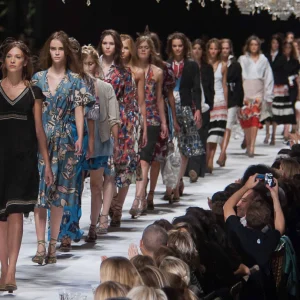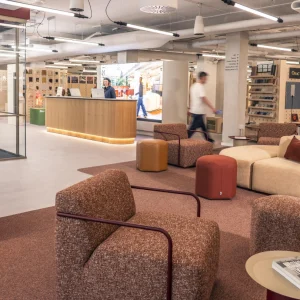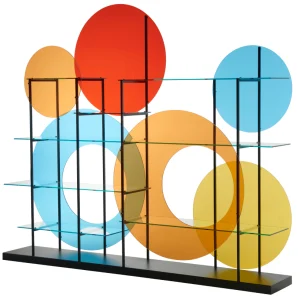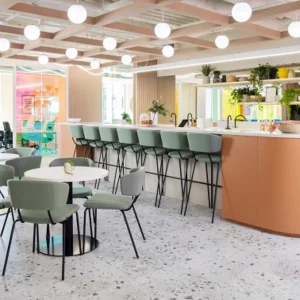The Casa das Historias Paula Rego seems to be that rare project which has brought together an enlightened client, a brilliant architect and powerful subject matter. At first the combination of architect Eduardo Souto de Moura and the figurative artist Paula Rego seems unlikely: an architect known for his interest in minimalism and an artist world-reknowned for her soulful expression and love of folk-tales. Yet the pairing makes clear that both share a sensitivity for universal values of proportion, colour and composition, even if it’s impossible to make direct parallels between their work.
The building is a collection of forms that reflect the internal spaces of the museum. Unified by a single material – coloured concrete – it sits comfortably within an oasis of lush grass and mature Eucalyptus trees, as if it were a farm or ranch. An ancient wall of rough-cast render protects the site, once La Parada, a garden where aristocrats and royalty would ride and play sports.
In 2002 the newly elected mayor of Cascais, António d’Orey Capucho, had proposed a strategy to use tax collected from the casino and from the area’s wealthy residents to invest in a 12-year development strategy to create a ‘contemporary architectural heritage’ that would provide a new impetus for tourists to visit Cascais. The Casa das Historias would become a key component of the strategy, and one of the only entirely new buildings. Cascais participated in the Lisbon Architecture Triennale in 2007 and showed 38 high-quality projects, including refurbishments; new public facilities such as schools and libraries; cultural buildings such as the Casa das Historias; the SantaMarta lighthouse museum, and the competition entries for an information centre in the town square.
This ambitious programme is scheduled to run for another four years, and is being implemented by the council’s impressive head of culture, Ana Clara Justino, a former secondary school teacher, who also acted as the client for the Casa das Historias. ‘Until recently we didn’t have anything of international quality or to attract tourism,’ says Justino, ‘but whatever we build has to be small scale: we’re not trying to rival Bilbao.’
Most of the projects have been refurbishments, but even these have been opportunities to make strong statements about contemporary Portuguese architecture. The superb SantaMarta Lighthouse museum by AiresMateus is one such example. A historic lighthouse was restored and a new building carefully added in the form of a series of white pavilions, shaped like castellations. Each houses parts of the new programme: shop, washrooms and cafe. Completed in 2007, the museum is a work of great subtlety and made an important statement about Cascais’s ambition to create a new distinctive architectural character.
Although in most cases the starting point for the new work has been an existing structure, or in the case of the Casa das Historias, vernacular forms, the influenceof the northern Porto School of Architecture has been important. According to Justino, ‘the northern architects give us the response to the site that we want for a series of small, human-scale projects’. Carlos Bessa, architect and assistant to Justino at the Department of Culture, studied in Porto and has been a strong advocate for the Porto school, along with Cascais’s head of planning Diogo Capucho, an architect (and son of the Mayor).
Next year, the council will pass over control of the Casa das Historias to a charitable foundation made up of key representatives including Paula Rego’s daughter, Carolina Willing, and a representative of Marlborough Fine Art gallery, which Rego joined in 1989.
Rego is a heroic figure in Portugal. She is the country’s best-known artist, but she also has a public profile after speaking out about politics and in particular the role of women in Portuguese society. In 1997, when the country had a national referendum on the subject of abortion rights, she exhibited a powerful series of paintings of women undergoing abortions, Untitled, at the Calouste Gulbenkian Foundation in Lisbon. She was highly critical of the fact that many people chose not to vote, which meant that the practise continued to be illegal.
Her work, though produced from a studio in Kentish Town, is infused with Portuguese character: women with strong features, black hair and full skirts, and the colours of the Portuguese architecture and landscape. Since 1988 her regular model has been a compatriot, Lila Nunes, who nursed her husband in the final years of his life.
Rego has always insisted that the most important aspect of her work is its narrative content.Most of her paintings and drawings tell stories based on her own memories, or other stories or situations that often express outrage about the human condition, and particularly that of women. She is inspired by illustrators and filmmakers (earlyWalt Disney and Luis Buñuel) rather than by fine artists.
The choice of architect was made by Rego. She’d been impressed by the London Serpentine pavilion of 2005 designed by Alvaro Siza and Eduardo Souto deMoura, and Souto deMoura’s Braga stadium (2000): ‘I heard he had done a football stadium in a cave and thought that he was particularly imaginative’.
Hence Casa das Historias is one of the few architectural projects in Cascais that resulted from a direct commission rather than from a competition.
Rego’s work is so strong – at times monstrous – that her modest, charming persona comes as something of a surprise. A few days before the grand opening of the Casa das Historias, she seemed nervous, telling me that the most important thing is not for people to see her work, but to ‘bring attention and energy to folk tales and story-telling’. Rego describes herself as a ‘drawer’, rather than an artist, and drawing is a thread that runs through the permanent and temporary exhibitions (the latter is taken from the Marlborough Fine Art’s collection and will be on display until 2010). The role of lines, whether in the large pastel works (where the lines are never smudged), or in etchings and lithographs, is central to Rego’s work.
The museum’s permanent collection is made up of 257 etchings and 278 drawings, many of which have never been seen before, that Rego has donated to the foundation. She has also loaned 52 paintings, many from the 1980s (for example the Operas series); and certain works from the 1960s and 1990s. Willing, apart from being husband and father to her three children, was a hugely important figure in the development of her work, and he is represented in the collection with 15 oil paintings, which will be exhibited in a retrospective of his career fromMarch 2010.
Souto deMoura’s abstract architecture is suprisingly sympathetic to her approach. The mono-material and coloured facades are a backdrop for a number of mature trees, whose irregular trunks and branches appear on the walls in silhouette as if they were hand-drawn lines. The terracotta colour is very much part of the area, occurring on terracotta roof tiles and plant pots and in the warm-toned render of neighbouring villas.
According to Sergio Koch, project architect, the references in colour and form are a mix of local vernacular and early-20th century houses. One very direct reference seems to be the twin chimneys of Sintra Palace, although these are conical and grey. In fact, the forms are a mix of references, but very much evoke the coastal fortresses, lighthouses, and agricultural silos of Cascais. To determine the precise colour, Souto deMoura experimented with several samples of concrete, adjusting the dye until it was right. The construction was apparently simple, using shuttering made from timber planks instead of large panels. Although the technique is not unusual, says Koch, ‘everything is studied to the millimetre. Every joint length and height of timber.’ The result is reduced to the point of feeling primitive. Horizontally shuttered concrete rests on a base of marble, and when the walls slope in to form two geometric forms, the shuttering makes a herringbone pattern, like a wall drawing by Sol LeWitt. The colouring is not quite as precise: the rusty red is satisfyingly uneven and painterly.
Inevitably, the twin turrets are the features of Souto deMoura’s building that will make their way on to tourist leaflets and into magazines. These are the only interior spaces where the architecture is more important than what is inside, housing a very well-researched bookshop and a bar/restaurant. The effect, looking up, is reminiscent of a James Turrell Skyspace: a square of light sky above a void; or a large kitchen fireplace where the room and the hearth are the same.
The plan of Casa das Historias is a rational composition of rectangles grouped around the central exhibition space, the largest gallery, and with the twin chimneys to the left side of the entrance hall.
Creating a place and a building for a specific body of work is not something an architect is often asked to do. The majority of newly built art museums are for mixed collections, or indeterminate temporary exhibitions. Casa das Historias, therefore, raises the possibility of how and whether architecture should seek to reflect the character of the work within it, or alternatively act as a foil against it. The combination of Rego and Souto deMoura is a good balance: the output of both has exuberance, powerful forms and tells its own stories. Yet the two artists use entirely specific and independent means of expression. The Casa das Historias is a magical house for stories in more ways than one, and all are worth exploring.





